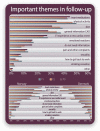Use of health services and perceived need for information and follow-up after percutaneous coronary intervention
- PMID: 38183067
- PMCID: PMC10768322
- DOI: 10.1186/s13104-023-06662-y
Use of health services and perceived need for information and follow-up after percutaneous coronary intervention
Abstract
Objective: Few patients achieve full control of their coronary artery disease (CAD) risk factors. Follow-up, such as cardiac rehabilitation, is important to increase adherence to lifestyle changes and treatment, to improve the patient's risk profile, and to treat established complications of CAD clinical events. However, the type of follow-up patients receive varies. Therefore, the aim of this research note was to describe and compare patients' self-reported use of health services, the type of follow-up patients reported to prefer, and the type of information patients reported to be important, in two countries with different follow-up practices after PCI.
Results: We included 3417 patients in Norway and Denmark, countries with different follow-up strategies after PCI. The results showed large differences between the countries regarding health services used. In Denmark the most frequently used health services were consultations at outpatient clinics followed by visits to the general practitioner and visits to the fitness centre, whereas in Norway visits to the general practitioner were most common, followed by rehospitalisation and no follow-up used. However, patients found the same type of follow-up and information important in both countries. Patients' perceived need for follow-up and information decreased over time, suggesting a need for early follow-up when the patients are motivated.
Trial registration: NCT03810612 (18/01/2019).
Keywords: Follow up care; Health services; Percutaneous coronary intervention.
© 2024. The Author(s).
Conflict of interest statement
The authors declare that they have no competing interests.
Figures




Similar articles
-
Rethinking rehabilitation after percutaneous coronary intervention: a protocol of a multicentre cohort study on continuity of care, health literacy, adherence and costs at all care levels (the CONCARDPCI).BMJ Open. 2020 Feb 12;10(2):e031995. doi: 10.1136/bmjopen-2019-031995. BMJ Open. 2020. PMID: 32054625 Free PMC article.
-
Association between perceived health and adherence to treatment after percutaneous coronary intervention: A long-term follow-up study.J Adv Nurs. 2022 Jun;78(6):1653-1664. doi: 10.1111/jan.15069. Epub 2021 Oct 12. J Adv Nurs. 2022. PMID: 34636444
-
Challenges adhering to a medication regimen following first-time percutaneous coronary intervention: A patient perspective.Int J Nurs Stud. 2018 Dec;88:16-24. doi: 10.1016/j.ijnurstu.2018.07.013. Epub 2018 Jul 26. Int J Nurs Stud. 2018. PMID: 30165236
-
Behavioural modification interventions for medically unexplained symptoms in primary care: systematic reviews and economic evaluation.Health Technol Assess. 2020 Sep;24(46):1-490. doi: 10.3310/hta24460. Health Technol Assess. 2020. PMID: 32975190 Free PMC article.
-
Stroke Rates Following Surgical Versus Percutaneous Coronary Revascularization.J Am Coll Cardiol. 2018 Jul 24;72(4):386-398. doi: 10.1016/j.jacc.2018.04.071. J Am Coll Cardiol. 2018. PMID: 30025574
Cited by
-
Association of obstructive sleep apnea with cardiovascular events in acute coronary syndrome patients with dual risk of remnant cholesterol and low-grade inflammation: a post-hoc analysis of the OSA-ACS study.Sleep Breath. 2025 Mar 8;29(1):119. doi: 10.1007/s11325-025-03281-8. Sleep Breath. 2025. PMID: 40056262
References
-
- Arnett DK, Blumenthal RS, Albert MA, et al. 2019 ACC/AHA guideline on the primary prevention of cardiovascular disease: executive summary: a report of the American College of Cardiology/American Heart Association Task Force on Clinical Practice Guidelines. Circulation. 2019;140:e563–e595. doi: 10.1161/CIR.0000000000000677. - DOI - PMC - PubMed
MeSH terms
Associated data
Grants and funding
LinkOut - more resources
Full Text Sources
Medical
Miscellaneous

